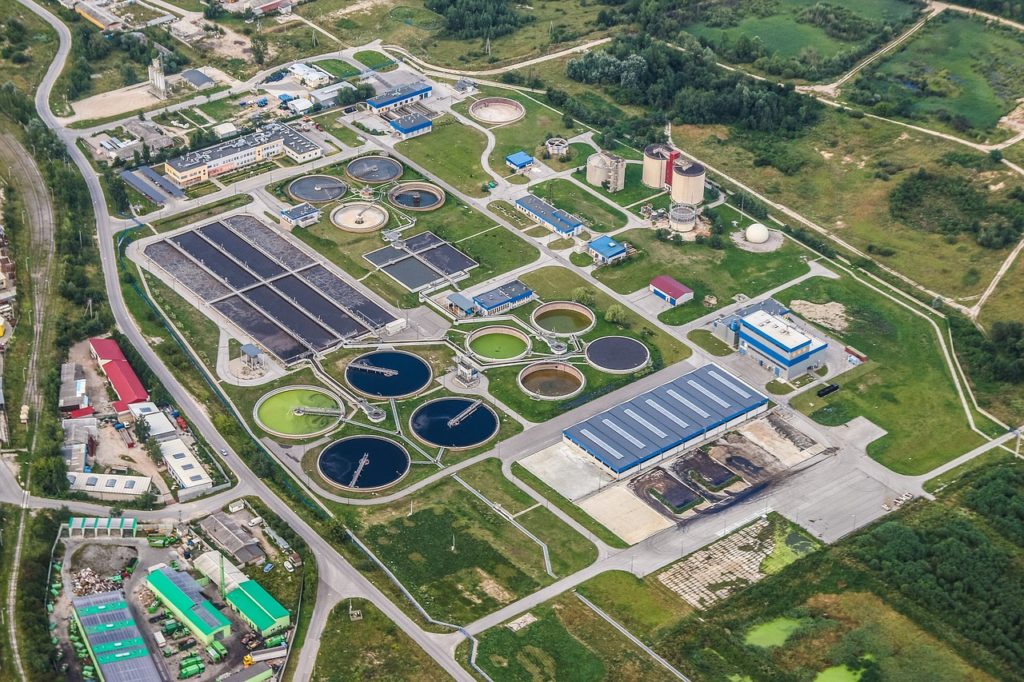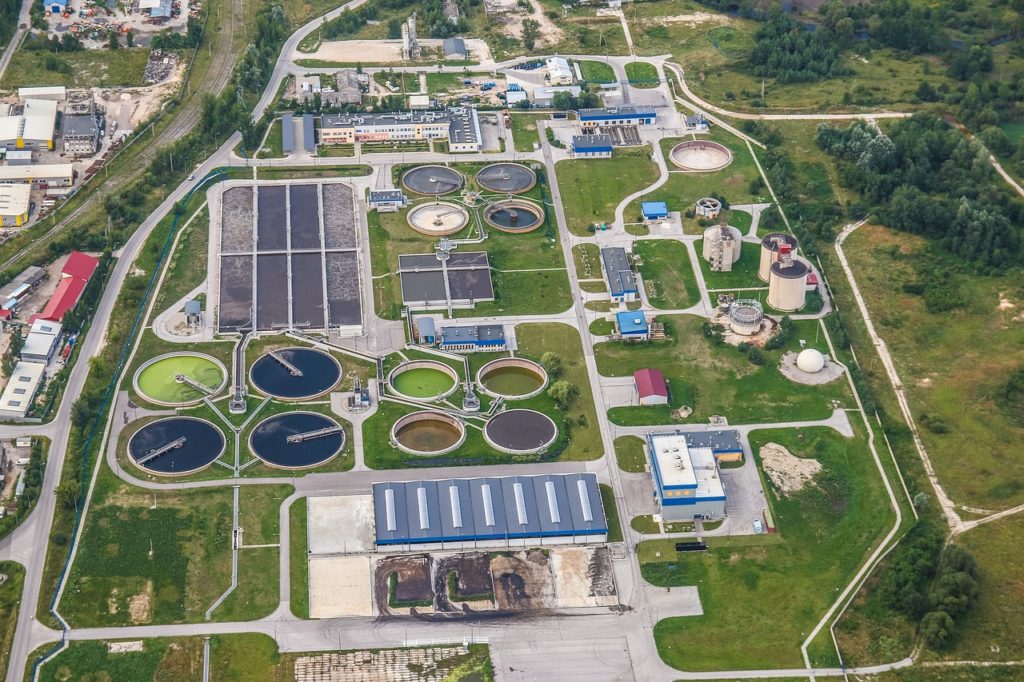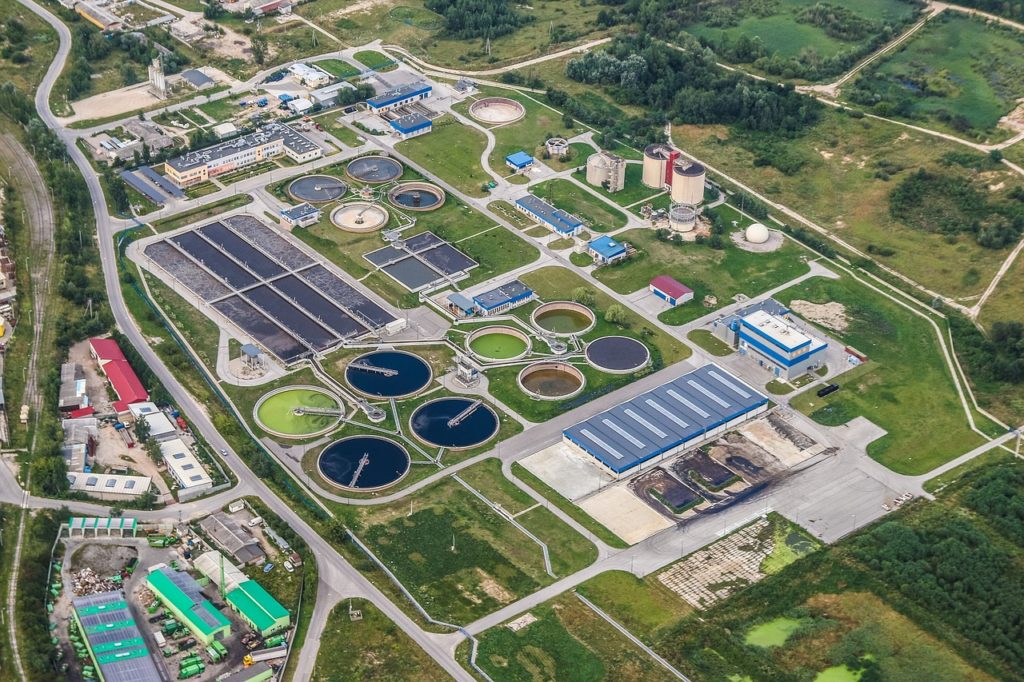In this article, you will gain a clear understanding of how a wastewater treatment plant works. Ever wondered what happens to your household wastewater once it’s flushed down the drain? Well, prepare to be amazed as we take you on a journey through the intricate process that occurs before clean water is returned to the environment. From initial filtration to chemical treatments, you’ll discover how these plants effectively remove pollutants and ensure the safety of our water sources. So, let’s dive into this fascinating world of wastewater treatment together.

Overview of a Wastewater Treatment Plant
Introduction to wastewater treatment
Wastewater treatment is the process of removing pollutants and contaminants from wastewater and making it safe to be returned to the environment or reused. This process is crucial to protect human health, preserve the quality of water bodies, and maintain the overall balance of ecosystems.
Importance of wastewater treatment
Wastewater treatment plays a vital role in maintaining the health and well-being of communities. By removing harmful substances, such as bacteria, viruses, chemicals, and solid materials, from wastewater, it prevents the spread of diseases, protects local water sources, and maintains the quality of the environment. Moreover, treating wastewater allows for its safe reuse in certain applications, conserving water resources and promoting sustainability.
Primary goals of a wastewater treatment plant
The primary goals of a wastewater treatment plant are to effectively remove pollutants from wastewater, ensure compliance with environmental regulations and standards, and protect public health. Additionally, wastewater treatment plants aim to minimize the impact on the environment by reducing the release of contaminants into water bodies and preventing pollution-related disasters.
Wastewater Collection and Preliminary Treatment
Collection of wastewater
The first step in the wastewater treatment process is the collection of wastewater from various sources, such as homes, businesses, and industries. This collected wastewater, also known as influent, is transported through a network of underground pipes called sewer lines to the treatment plant.
Screening
Once the influent reaches the treatment plant, it undergoes a preliminary treatment process to remove large objects and debris. Screens or bars with small gaps are used to trap and remove items such as plastics, branches, and rags. This screening process prevents these materials from clogging pumps, pipes, and other equipment in the treatment plant.
Grit removal
After the screening process, the wastewater undergoes grit removal. Grit includes sand, gravel, and other heavy particles that may cause damage to equipment or hinder subsequent treatment processes. This grit removal is typically achieved through the use of grit chambers or vortex separators, where the water flow is slowed down, allowing heavier particles to settle and be removed.
Primary sedimentation
The next step in the preliminary treatment stage is primary sedimentation. Wastewater flows into large sedimentation tanks, also known as primary clarifiers, where the velocity of the water is reduced, allowing heavier suspended solids to settle at the bottom. The settled solids, known as primary sludge, are then collected and transported for further treatment, while the clarified water moves on to the next phase of the treatment process.

Secondary Treatment
Introduction to secondary treatment
Secondary treatment is the core process in wastewater treatment, designed to further remove dissolved and suspended organic matter from the water. The objective is to significantly reduce the biochemical oxygen demand (BOD) and total suspended solids (TSS) levels in the effluent before it is discharged back into the environment.
Biological processes
The heart of secondary treatment lies in the use of biological processes. These processes harness the power of naturally occurring microorganisms to break down and consume organic substances present in the wastewater, converting them into harmless byproducts. This is achieved through two main processes: aerobic and anaerobic.
Activated sludge process
The activated sludge process is a widely used method in secondary treatment. In this process, the wastewater is mixed with a large population of microorganisms, known as activated sludge, in a tank called the aeration basin. Oxygen is then continuously supplied to the basin to support the growth and activity of aerobic bacteria, which break down the organic matter into carbon dioxide, water, and more sludge.
Trickling filters
Another common method of secondary treatment is trickling filters. These filters consist of a bed of media, such as stones or plastic materials, on which a layer of microbial growth, or biofilm, develops. Wastewater is distributed over the media, and as it trickles through the biofilm, the microorganisms consume the organic compounds. The treated water then moves on to the subsequent treatment stages.
Sequencing batch reactors (SBR)
Sequencing batch reactors (SBRs) are flexible and efficient systems used in secondary treatment. They operate in cycles or batches, incorporating aeration, settling, and decanting stages in a single tank. During the aeration phase, microorganisms consume the organic matter. Then, the wastewater is allowed to settle to separate the treated water from the remaining sludge. Finally, the clear water is decanted for further treatment or discharge.
Anaerobic treatment
Anaerobic treatment is an alternative method used in some wastewater treatment plants. This process relies on anaerobic bacteria that thrive in environments without oxygen. These bacteria break down organic matter in the absence of oxygen, producing biogas, such as methane, as a byproduct. Anaerobic treatment is particularly useful in handling high-strength waste streams or producing energy from wastewater.
Tertiary Treatment
Purpose of tertiary treatment
While secondary treatment significantly improves the quality of the water, certain contaminants may still remain. Tertiary treatment provides an additional level of purification to ensure that the effluent meets strict water quality standards. This level of treatment is often required when the treated wastewater is intended for reuse in applications such as irrigation or industrial processes.
Filtration
Filtration is a vital component of tertiary treatment. The water passes through various filtration systems, such as sand filters or membrane filters, to remove any remaining suspended solids, bacteria, and other fine particles. These filters physically trap the contaminants, allowing only the clean water to pass through.
Disinfection
Disinfection is another critical step in tertiary treatment. It aims to eliminate any remaining pathogens, such as bacteria, viruses, and parasites, that may be present in the effluent. Common disinfection methods include the use of chlorine, ozone, ultraviolet (UV) light, or other advanced oxidation processes. These methods destroy or inactivate the microorganisms, ensuring the water is safe for reuse or discharge.
Chemical treatment
Chemical treatment processes are sometimes employed in tertiary treatment to address specific contaminants that may not be efficiently removed by filtration or disinfection alone. Chemical coagulants or flocculants, such as alum or polymers, are added to the water to facilitate the aggregation of fine particles and enhance their removal. This step further improves the clarity and quality of the treated water.
Nutrient removal
In some cases, wastewater treatment plants must also address the removal of nutrients, such as nitrogen and phosphorus, during tertiary treatment. Excessive discharge of these nutrients can lead to harmful algal blooms and disrupt aquatic ecosystems. Various processes, including biological and chemical methods, can be employed to remove or reduce nutrient concentrations to environmentally safe levels.

Sludge Treatment and Disposal
Introduction to sludge treatment
Throughout the wastewater treatment process, solids that are removed from the wastewater, including primary sludge and excess activated sludge, are collectively referred to as sludge. Sludge treatment is a crucial step to minimize the volume and stabilize the sludge, making it safe for disposal or beneficial reuse.
Thickening
Sludge thickening is the initial step in sludge treatment. It involves increasing the solids content of the sludge by removing excess water. Various methods, such as gravity thickeners, centrifuges, or dissolved air flotation, can be used to separate the water from the sludge, resulting in a more concentrated and manageable sludge volume.
Sludge digestion
Sludge digestion is a biological process used to break down organic matter in the sludge and convert it into more stable compounds. Anaerobic digestion is the most common method employed, where the sludge is placed in a sealed tank without oxygen. Anaerobic bacteria decompose the organic matter, producing biogas as a valuable byproduct, which can be utilized as an energy source.
Dewatering
Dewatering is the process of removing the remaining water from the digested sludge, creating a semi-solid material called cake. This is typically achieved through mechanical methods, such as centrifuges, belt filter presses, or drying beds. Dewatering significantly reduces the volume and weight of the sludge, making it more economical to transport and dispose of or utilize for various applications.
Sludge disposal options
Once dewatered, the sludge can be disposed of in several ways, depending on local regulations and the characteristics of the sludge. Common options include landfill disposal, where the sludge is disposed of in designated areas; incineration, where the sludge is burned at high temperatures; or beneficial reuse, where the sludge is treated further and utilized as fertilizer, soil conditioner, or energy source.
Advanced Treatment Processes
Overview of advanced treatment
Advanced treatment processes go beyond the conventional methods to address specific contaminants or achieve higher levels of water quality. These processes are often employed in situations where the wastewater contains complex or challenging substances that require specialized treatment.
Membrane bioreactors (MBR)
One advanced treatment method is the membrane bioreactor (MBR). MBR combines biological treatment, such as the activated sludge process, with the use of membranes to separate the treated water from the biomass. This results in a higher quality effluent, as the membranes act as a physical barrier, preventing the passage of suspended solids and microorganisms.
Ultraviolet (UV) disinfection
UV disinfection is a powerful and environmentally-friendly method used to disinfect water without the use of chemicals. In this process, UV light is emitted from specialized lamps, effectively destroying the genetic material of microorganisms, rendering them unable to reproduce. UV disinfection is particularly effective against bacteria, viruses, and other pathogens, ensuring the treated water is safe for use or discharge.
Ozonation
Ozonation is a highly efficient process that uses ozone, a strong oxidizing agent, to treat wastewater. Ozone is generated on-site and introduced into the water, where it reacts with and breaks down various contaminants. It can effectively destroy microorganisms, remove color and odor, and break down complex organic compounds, making it highly suitable for treating challenging wastewater.
Advanced oxidation processes (AOPs)
Advanced oxidation processes (AOPs) are highly advanced treatment methods used for the removal of persistent organic pollutants. AOPs involve the generation of highly reactive oxidizing species, such as hydroxyl radicals, through the combination of different techniques, including UV radiation, hydrogen peroxide, or ozone. These reactive species can effectively degrade or transform a wide range of organic compounds, ensuring the removal of complex and resistant contaminants.
Reverse osmosis (RO)
Reverse osmosis (RO) is an advanced and efficient desalination process that can be applied in wastewater treatment. RO utilizes a semi-permeable membrane to separate the treated water from dissolved salts and other contaminants. By applying pressure to the wastewater, the water molecules pass through the membrane, leaving behind the concentrated brine solution. RO is particularly valuable in water-scarce regions or for the production of high-quality water for industrial processes.
Effluent Discharge and Environmental Impact
Effluent standards and regulations
Effluent standards and regulations set the guidelines and limits for the quality of treated wastewater that can be discharged back into the environment. These standards vary across countries and regions, but they generally focus on parameters such as BOD, TSS, turbidity, pH, and specific contaminants. Compliance with these standards is essential to ensure the protection of receiving water bodies and the health of surrounding ecosystems.
Monitoring and testing
To ensure compliance with effluent standards and regulations, wastewater treatment plants implement rigorous monitoring and testing programs. Samples of the treated water are regularly collected and analyzed for various parameters by trained personnel. This monitoring allows for early detection of any deviations from the required standards and enables prompt corrective actions to maintain environmental compliance.
Environmental impact assessment
Wastewater treatment plants undergo thorough environmental impact assessments before construction and during operation. These assessments evaluate potential environmental impacts, such as changes in water quality, habitat destruction, or disruption of ecosystems. By understanding these impacts, appropriate mitigation measures can be implemented to minimize any negative effects on the environment.
Impact on aquatic ecosystems
Effluent discharge from wastewater treatment plants can have profound effects on aquatic ecosystems. Nutrient enrichment, particularly of nitrogen and phosphorus, can lead to eutrophication, causing excessive algal growth and oxygen depletion. To mitigate these impacts, additional treatment processes, such as tertiary treatment, are necessary to ensure the removal of significant nutrient loads, protecting aquatic ecosystems and maintaining the ecological balance.
Sustainability and Energy Efficiency
Energy usage in wastewater treatment
Wastewater treatment plants consume significant amounts of energy due to the various mechanical and biological processes involved. This energy usage includes powering pumps, aerators, mixers, and other equipment, as well as the treatment of sludge. Minimizing energy consumption is crucial to reduce the environmental footprint and operating costs of wastewater treatment plants.
Renewable energy sources
To promote sustainability and energy efficiency, many wastewater treatment plants are implementing renewable energy sources. Solar panels, wind turbines, and hydropower systems are being utilized to generate clean energy on-site, reducing reliance on the grid and reducing greenhouse gas emissions. Additionally, the utilization of biogas generated from sludge digestion as an energy source further contributes to the sustainability of the treatment process.
Energy efficiency measures
Wastewater treatment plants are adopting various energy efficiency measures to optimize energy usage. These measures include the use of energy-efficient equipment, such as pumps and motors, optimizing process control algorithms to minimize energy wastage, and implementing energy management systems to monitor and optimize energy consumption.
Resource recovery
In addition to energy recovery from biogas, wastewater treatment plants are increasingly adopting resource recovery practices. These practices aim to extract valuable resources, such as nutrients, organic matter, and water, from wastewater and sludge. Nutrient recovery technologies, for example, facilitate the extraction of phosphorus and nitrogen from the wastewater for use as fertilizers, while the recovered water can be treated further for reuse in non-potable applications like irrigation or industrial processes.
Challenges and Future Trends
Current challenges in wastewater treatment
Wastewater treatment faces various challenges, including population growth, aging infrastructure, tighter regulatory standards, and emerging contaminants. The increasing population puts additional pressure on wastewater treatment plants, demanding an expansion and upgrade of existing facilities. Moreover, the presence of emerging contaminants, such as pharmaceuticals and microplastics, presents new challenges in achieving effective treatment and removing these substances from the wastewater.
Resource scarcity and population growth
Increasing resource scarcity and population growth further highlight the need for sustainable wastewater treatment practices. As water resources become scarcer, treating and reusing wastewater becomes crucial for water security. Additionally, with population growth, the demand for clean water and effective wastewater treatment will continue to rise, necessitating innovative and sustainable solutions.
Technological advancements
Technological advancements play a significant role in shaping the future of wastewater treatment. Emerging technologies, such as advanced sensors, automation, artificial intelligence, and data analytics, offer opportunities for enhanced process control, optimization, and efficiency. These technologies enable real-time monitoring, proactive maintenance, and predictive modeling, improving the overall performance and reliability of wastewater treatment plants.
Decentralized wastewater treatment
Decentralized wastewater treatment systems are gaining attention as a solution to address the challenges faced by centralized treatment plants. These systems treat wastewater at or near the source, reducing the need for extensive sewer networks and long-distance transportation. Decentralized systems can be cost-effective, provide localized treatment solutions, and promote more efficient water use in water-stressed areas.
Water reuse and recycling
Water reuse and recycling are becoming increasingly important in water-scarce regions. By treating wastewater to a high standard, it can be safely utilized for various non-potable uses, such as irrigation, industrial processes, and toilet flushing. Promoting water reuse not only conserves valuable freshwater resources but also reduces the burden on wastewater treatment plants and protects the environment.
Conclusion
Summary of wastewater treatment process
Wastewater treatment plants play a crucial role in safeguarding public health, protecting the environment, and maintaining sustainable water resources. The process of wastewater treatment involves multiple stages, including collection, preliminary treatment, secondary treatment, tertiary treatment, sludge treatment, and advanced treatment processes. Each stage focuses on the removal of specific contaminants and achieving the desired water quality standards.
Importance of effective wastewater treatment
Effective wastewater treatment is of paramount importance for the well-being of communities and the sustainability of our environment. It prevents the spread of diseases, protects water bodies, conserves water resources, and promotes resource recovery. Ensuring that wastewater is properly treated before it is discharged or reused is essential to safeguard public health, preserve aquatic ecosystems, and support sustainable development.
Future outlook and the need for innovation
As the global population continues to grow and environmental challenges persist, ongoing research, innovation, and investment in wastewater treatment are crucial. The development and implementation of new technologies, increased resource recovery practices, water reuse initiatives, and decentralized treatment systems will shape the future of wastewater treatment. By embracing innovation and adapting to emerging challenges, we can ensure the continued protection of our water resources and the well-being of future generations.

